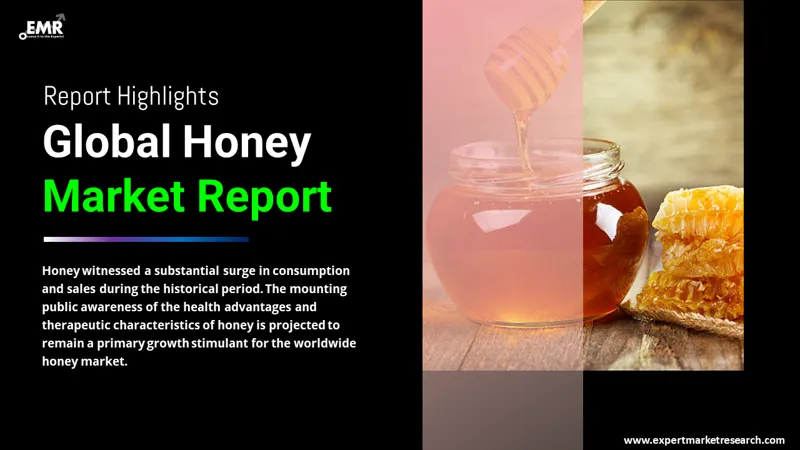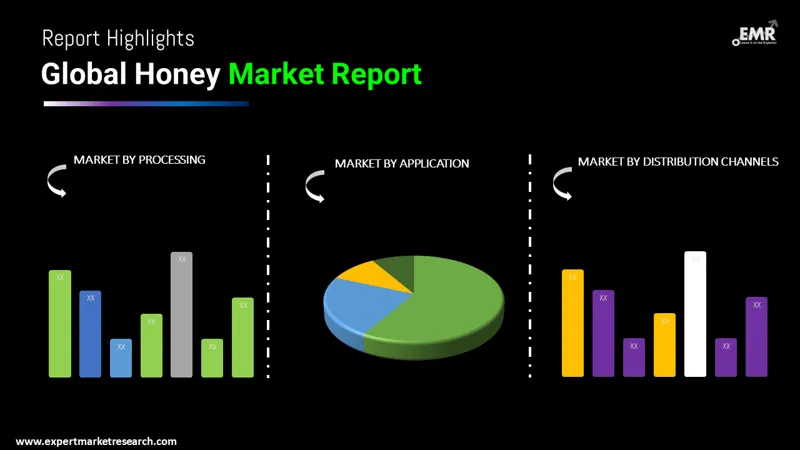
Consumer Insights
Uncover trends and behaviors shaping consumer choices today
Procurement Insights
Optimize your sourcing strategy with key market data
Industry Stats
Stay ahead with the latest trends and market analysis.
Trending Now



The global honey market size, in terms of production value, was around USD 9.77 Billion in 2024. The market has been assessed to grow at a CAGR of 4.62% in the forecast period of 2025-2034, to reach a value of USD 15.35 Billion by 2034. The global honey market size has been expanding steadily, driven by the increasing demand for nutritional ingredients in daily diets. Honey is packed with essential vitamins, minerals, and calcium, making it a preferred natural alternative to artificial sweeteners. Rich in antioxidants, it is widely used in nutritious food products, supporting a healthy lifestyle. The COVID-19 pandemic further boosted honey consumption due to its antibacterial, antiviral, and anti-fungal properties. It has long been used in medicine to treat acute cough, throat infections, and even as a remedy for corona-infected patients. The medicinal and dietary benefits of honey continue to influence consumer preferences, shaping the market’s future expansion.
Base Year
Historical Year
Forecast Year






Value in USD Billion
2025-2034
Honey Market Outlook
*this image is indicative*
Read more about this report - REQUEST FREE SAMPLE COPY IN PDF
Honey is a versatile product used in various industries, including beverages, processed foods, jams, jellies, and health and beauty products. Rising market demand is fueled by its medical characteristics, which help boost metabolic activity, control blood pressure, and lower the risk of diabetes. Additionally, honey is known to treat burn wounds and is widely used in cosmetics and pharmaceuticals. The surge in consumer preference for natural and organic ingredients is significantly contributing to market growth, as people look for functional foods that offer health benefits alongside nutritional value. The growing application of honey in various sectors continues to reinforce its market presence.
Product manufacturers are focusing on innovative launches, introducing honey-infused syrups, syrups and spreads, and products with no added sugar to cater to the demand for a healthier version of sweeteners. The development of honey-based strawberry syrups and alternatives to sugary chocolates is growing, driven by increasing health consciousness. Consumers are shifting towards natural sweeteners, appreciating their antioxidant properties and antibacterial properties. The preference for honey as a sweetener choice is also rising due to its longer shelf life and high affordability. As awareness of honey’s benefits grows, the demand for natural sweeteners is expected to continue driving market growth in the coming years.
| Global Honey Market Report Summary | Description | Value |
| Base Year | USD Billion | 2024 |
| Historical Period | USD Billion | 2018-2024 |
| Forecast Period | USD Billion | 2025-2034 |
| Market Size 2024 | USD Billion | 9.77 |
| Market Size 2034 | USD Billion | 15.35 |
| CAGR 2018-2024 | Percentage | XX% |
| CAGR 2025-2034 | Percentage | 4.62% |
| CAGR 2025-2034 - Market by Region | Asia Pacific | 5.3% |
| CAGR 2025-2034 - Market by Country | India | 6.1% |
| CAGR 2025-2034 - Market by Country | China | 5.1% |
| CAGR 2025-2034 - Market by Processing | Organic | 6.5% |
| CAGR 2025-2034 - Market by Application | Food and Beverage | 5.2% |
| Market Share by Country 2024 | India | 3.7% |

Read more about this report - REQUEST FREE SAMPLE COPY IN PDF
The conventional segment dominates the global honey market due to its wider availability and lower prices, making it a preferred choice among consumers. Despite this, the organic segment is witnessing the fastest CAGR, driven by increasing consumer demands for organic honey as part of the growing trend of eating healthy. Millennials and adults are actively seeking new flavors and exotic add-ons, boosting innovation in both conventional products and premium organic offerings. As consumers shift towards healthier lifestyles, the revenue share of organic honey is expected to rise, challenging the long-standing dominance of the conventional segment in the market.
The rising adoption of plant-based sweeteners is influencing the demand for natural honey sweeteners, accelerating market growth. A growing population interested in sustainable choices is driving the expansion of honey sweeteners, including vegan honey alternatives. Several key players, such as Blenditup, Just Like Honey, and Vegan Honey Company, are actively developing innovative honey sweeteners to cater to evolving consumer preferences. These key players are capitalizing on the shift towards ethical consumption, ensuring sustainable production while maintaining the taste and texture of traditional honey. The market is expected to expand further as plant-based and natural alternatives gain traction.
The global honey market plays a significant role in the food and beverage industry, where it serves as a natural sweetener, often used as an additive in confectionery products, beverages, and baked goods. It is an ideal alternative to sugar, offering a desirable taste and texture while reducing the amount of refined sugar in food. Honey is preferred for its ability to enhance the flavour profile of various treats like confectionery products, making it a vital ingredient as a sweetener in the food sector.
In the pharmaceutical industry, honey is commonly incorporated into cough syrups and fluid dietary supplement products due to its natural anti-inflammatory and antibacterial properties. Its rich composition contributes to wellbeing upgrading properties, making it a valuable ingredient in health-related products. The soothing and healing effects of honey have made it a sought-after element in formulations aimed at alleviating common health issues, such as respiratory concerns.
In the personal care and cosmetics industry, honey is widely used for its skin benefits. Honey's usage in skincare products like cleansers, face wash, and creams helps to maintain skin moisture and provides soothing effects. As an anti-aging agent, honey contributes to improving the skin's texture and elasticity, which makes it a popular ingredient for enhancing the overall appearance and health of the skin.

Read more about this report - REQUEST FREE SAMPLE COPY IN PDF
The global honey market relies heavily on various distribution channels to ensure product availability across different consumer segments. The hypermarkets and supermarkets segment holds a significant revenue share, with independent retail giants like Walmart and Costco offering consumers easy access to honey products. This distribution model benefits from high product visibility, expanding the consumer base and aligning with evolving lifestyles. Online distribution channels are also growing, with a notable compound annual growth rate (CAGR), driven by changing purchasing patterns. The ease of shopping online and the ability to explore various honey options have made online channels an attractive choice for consumers, enhancing convenience and accessibility.
Online platforms are increasingly shaping the honey market, providing a seamless shopping experience for consumers seeking convenience and product visibility. These platforms offer a multitude of products, including varieties of honey, royal jelly, and wax, all available for at-home delivery. The growth of virtual stores has contributed to segment growth, while the return and exchange options adds consumer trust. Market players are keen on enhancing customer service to meet the rising demand for honey. The growing focus on consumer satisfaction, including fast delivery and easy return policies, ensures that these online channels remain highly competitive.
Europe holds a significant share in the global honey market, with its revenue share expected to increase during the forecast period. The rise in disposable income and urbanization in several European countries is driving changing lifestyles, influencing product demand. As consumers focus on healthy and tasty eating habits, honey consumption has surged, contributing to the market growth. The region is also witnessing a rising preference for natural and organic sweeteners, boosting honey’s popularity. In particular, demand for honey in countries like Germany and France is growing due to the growing awareness of its health benefits. The region's steady market growth is reflected in its CAGR, driven by these shifts in consumer behaviour, along with the influence of Asia Pacific's rising consumption.
The Asia Pacific region is witnessing remarkable growth in the honey market, due to the millennial population's increasing inclination toward healthier sweeteners. The demand for honey as an alternative to refined sugars is rising, especially in countries like China and India. Well-established players such as Jedwards International, Inc., Koru Natural, and Pacific Resources International are leading the market, strengthening their positions in the region. This growth is fueled by key players' expansion strategies and the rising production volume of honey to meet consumption demands. With the region's regional market growth accelerating, Asia Pacific is projected to become a dominant force in the global honey market.
| CAGR 2025-2034 - Market by | Country |
| India | 6.1% |
| China | 5.1% |
| Canada | 4.5% |
| UK | 4.2% |
| France | 3.6% |
| USA | XX% |
| Germany | XX% |
| Italy | XX% |
| Japan | 3.2% |
| Australia | XX% |
| Saudi Arabia | XX% |
| Brazil | XX% |
| Mexico | XX% |
It was founded in 1953 by beekeepers in Queensland, Australia. It started as a small, cooperative group and has grown into one of the top honey companies in Australia. The company is primarily known for its honey, including varieties like Manuka honey, organic honey, and a range of other floral varieties. They may also produce related products such as honeycomb, propolis, and royal jelly. Capilano is known for its commitment to quality as it sources honey from thousands of beekeeping families across Australia. This broad sourcing contributes to a diverse range of honey flavours and types.
New Zealand Honey Company is a New Zealand-based venture, which is known for the word famous Manuka honey. It was established in 2006 and has been growing at a very fast pace.
It is a US-based honey company, which was founded in 1960 and is based in Kansas, United States. Its flagship brand is Busy Bee.
It is essentially an India-based multinational FMCG company that had begun as an enterprise producing indigenous medicines. It diversified itself in a wide range of FMCG products. Dabur Honey is one of its major offerings.
*Please note that this is only a partial list; the complete list of key players is available in the full report. Additionally, the list of key players can be customized to better suit your needs.*
The global honey market report offers a comprehensive segmentation analysis, highlighting key revenue growth opportunities at global, regional, and country levels. The market is driven by the latest trends in honey processing, with various sub-segments focusing on specific product types and production techniques. Regional and country-level dynamics play a significant role in shaping demand, while distribution channels are evolving to meet consumer preferences. This segmentation provides valuable insights into opportunities across different regions, enabling businesses to capitalise on emerging trends and optimise strategies for growth in the global honey market.
Processing Outlook (Revenue, Billion, 2025-2034)
Application Outlook (Revenue, Billion, 2025-2034)
Distribution Channel Outlook (Revenue, Billion, 2025-2034)
Region Outlook (Revenue, Billion, 2025-2034)
*While we strive to always give you current and accurate information, the numbers depicted on the website are indicative and may differ from the actual numbers in the main report. At Expert Market Research, we aim to bring you the latest insights and trends in the market. Using our analyses and forecasts, stakeholders can understand the market dynamics, navigate challenges, and capitalize on opportunities to make data-driven strategic decisions.*
Get in touch with us for a customized solution tailored to your unique requirements and save upto 35%!
The size of honey market reached a production value of USD 9.77 Billion in 2024.
The market is estimated to attain a value of USD 15.35 Billion by 2034, expanding at a CAGR of 4.62% between 2025 and 2034.
The market is driven by the growing demand for honey in various personal care products and increasing investments by market players to meet the demand.
Key opportunities in the global honey market include expanding demand for organic honey, rising health-conscious consumers, and the growing trend of natural sweeteners in food and beverages, along with innovations in honey-based skincare products.
The regional markets for the global honey market include North America, Europe, Asia Pacific, Latin America, Middle East and Africa.
The types of processing available in the honey market include organic and conventional.
Honey finds extensive applications in food and beverage, personal care and cosmetics, pharmaceuticals, among others.
The distribution channels for honey include business to business and business to consumer. The business to consumer segment can be further bifurcated into hypermarkets and supermarkets, convenience stores, and online, among others.
Honey is known to provide antidepressant, anticonvulsant, and anti-anxiety benefits. It also has a rather lower glycemic index compared to sugar and does not affect the blood sugar levels as much.
The key players in the market include Barkman Honey, LLC, Dabur India Ltd, Capilano Honey Limited, African Bronze Honey Company, New Zealand Honey Co., Pastili Limited, Comvita Ltd., North Dallas Honey Company d/b/a Nature Nate, Streamland Honey Group Ltd, Beeyond the Hive, Oha Honey LP, Billy Bee Honey Products, Little Bee Impex, and Dutch Gold Honey, Inc., among others.
The food and beverage industry dominates the global honey market, where it serves as a natural sweetener, often used as an additive in confectionery products, beverages, and baked goods.
Companies like New Zealand Honey Co., Comvita, and Dutch Gold Honey dominate the global honey market, with Comvita holding a significant share due to its strong distribution networks, brand reputation, and premium honey offerings.
Factors driving growth include increasing demand for natural and organic products, while market restraints involve issues like honey adulteration, fluctuating raw material prices, and environmental factors such as climate change affecting honey production.
Explore our key highlights of the report and gain a concise overview of key findings, trends, and actionable insights that will empower your strategic decisions.
| REPORT FEATURES | DETAILS |
| Base Year | 2024 |
| Historical Period | 2018-2024 |
| Forecast Period | 2025-2034 |
| Scope of the Report |
Historical and Forecast Trends, Industry Drivers and Constraints, Historical and Forecast Market Analysis by Segment:
|
| Breakup by Processing |
|
| Breakup by Application |
|
| Breakup by Distribution Channel |
|
| Breakup by Region |
|
| Market Dynamics |
|
| Competitive Landscape |
|
| Companies Covered |
|
Datasheet
One User
USD 2,499
USD 2,249
tax inclusive*
Single User License
One User
USD 3,999
USD 3,599
tax inclusive*
Five User License
Five User
USD 4,999
USD 4,249
tax inclusive*
Corporate License
Unlimited Users
USD 5,999
USD 5,099
tax inclusive*
*Please note that the prices mentioned below are starting prices for each bundle type. Kindly contact our team for further details.*
Flash Bundle
Small Business Bundle
Growth Bundle
Enterprise Bundle
*Please note that the prices mentioned below are starting prices for each bundle type. Kindly contact our team for further details.*
Flash Bundle
Number of Reports: 3
20%
tax inclusive*
Small Business Bundle
Number of Reports: 5
25%
tax inclusive*
Growth Bundle
Number of Reports: 8
30%
tax inclusive*
Enterprise Bundle
Number of Reports: 10
35%
tax inclusive*
How To Order
Our step-by-step guide will help you select, purchase, and access your reports swiftly, ensuring you get the information that drives your decisions, right when you need it.

Select License Type
Choose the right license for your needs and access rights.

Click on ‘Buy Now’
Add the report to your cart with one click and proceed to register.

Select Mode of Payment
Choose a payment option for a secure checkout. You will be redirected accordingly.
Track prices with detailed trend reports.

Analyse trade data for supply chain insights.

Leverage cost reports for smart savings

Enhance supply chain with partnerships.

Gain insights to stay ahead and seize opportunities.

Get insights & trends for a competitive edge.

Track prices with detailed trend reports.

Analyse trade data for supply chain insights.

Leverage cost reports for smart savings

Enhance supply chain with partnerships.

Gain insights to stay ahead and seize opportunities.

Get insights & trends for a competitive edge.

Track prices with detailed trend reports.

Analyse trade data for supply chain insights.

Connect For More Information
Our expert team of analysts will offer full support and resolve any queries regarding the report, before and after the purchase.
Our expert team of analysts will offer full support and resolve any queries regarding the report, before and after the purchase.
We employ meticulous research methods, blending advanced analytics and expert insights to deliver accurate, actionable industry intelligence, staying ahead of competitors.
Our skilled analysts offer unparalleled competitive advantage with detailed insights on current and emerging markets, ensuring your strategic edge.
We offer an in-depth yet simplified presentation of industry insights and analysis to meet your specific requirements effectively.



Australia
63 Fiona Drive, Tamworth, NSW
+61-448-061-727
India
C130 Sector 2 Noida, Uttar Pradesh 201301
+91-723-689-1189
Philippines
40th Floor, PBCom Tower, 6795 Ayala Avenue Cor V.A Rufino St. Makati City,1226.
+63-287-899-028, +63-967-048-3306
United Kingdom
6 Gardner Place, Becketts Close, Feltham TW14 0BX, Greater London
+44-753-713-2163
United States
30 North Gould Street, Sheridan, WY 82801
+1-415-325-5166
Vietnam
193/26/4 St.no.6, Ward Binh Hung Hoa, Binh Tan District, Ho Chi Minh City
+84-865-399-124
United States (Head Office)
30 North Gould Street, Sheridan, WY 82801
+1-415-325-5166
Australia
63 Fiona Drive, Tamworth, NSW
+61-448-061-727
India
C130 Sector 2 Noida, Uttar Pradesh 201301
+91-723-689-1189
Philippines
40th Floor, PBCom Tower, 6795 Ayala Avenue Cor V.A Rufino St. Makati City, 1226.
+63-287-899-028, +63-967-048-3306
United Kingdom
6 Gardner Place, Becketts Close, Feltham TW14 0BX, Greater London
+44-753-713-2163
Vietnam
193/26/4 St.no.6, Ward Binh Hung Hoa, Binh Tan District, Ho Chi Minh City
+84-865-399-124
Share